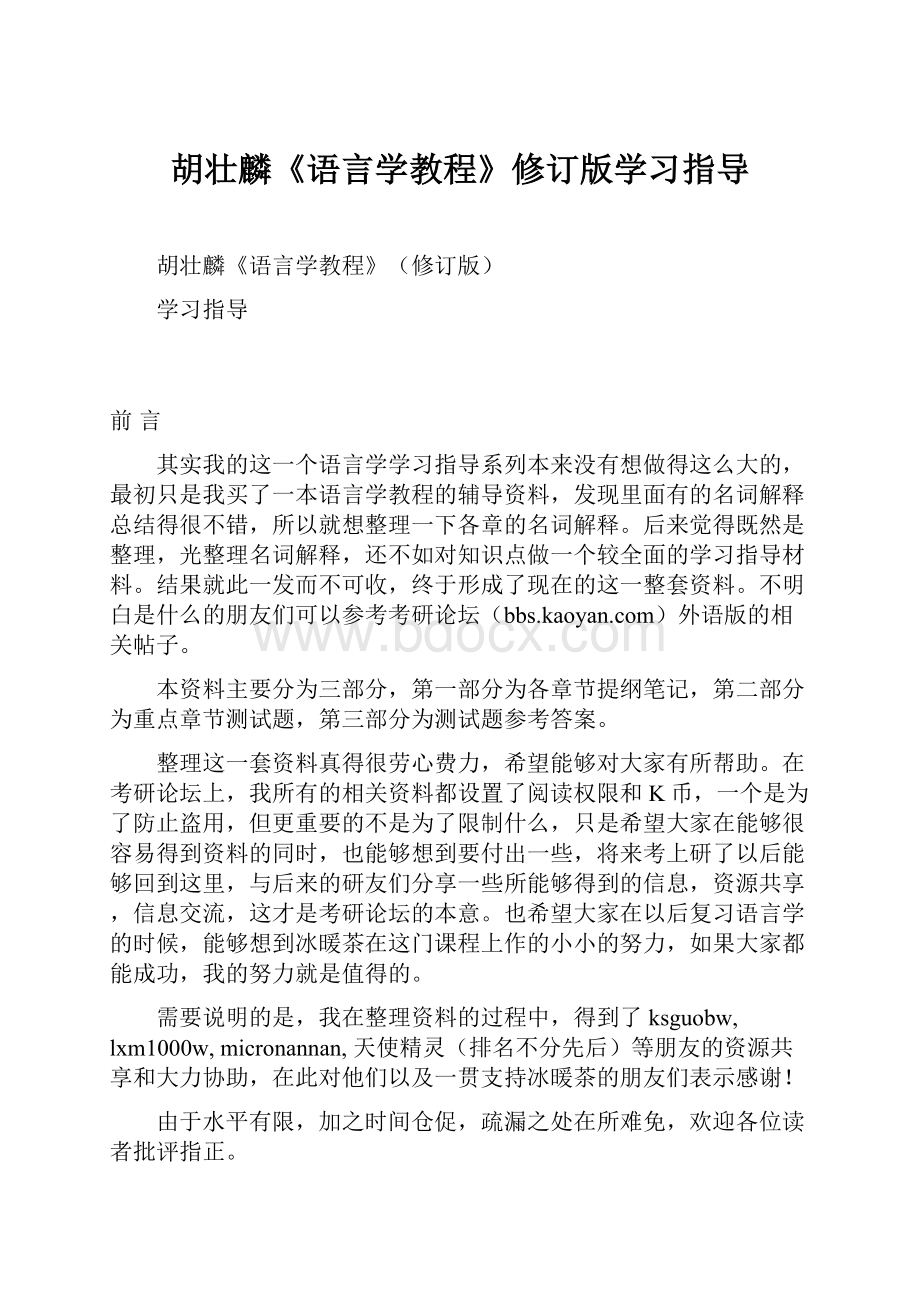胡壮麟《语言学教程》修订版学习指导.docx
《胡壮麟《语言学教程》修订版学习指导.docx》由会员分享,可在线阅读,更多相关《胡壮麟《语言学教程》修订版学习指导.docx(123页珍藏版)》请在冰豆网上搜索。

胡壮麟《语言学教程》修订版学习指导
胡壮麟《语言学教程》(修订版)
学习指导
前言
其实我的这一个语言学学习指导系列本来没有想做得这么大的,最初只是我买了一本语言学教程的辅导资料,发现里面有的名词解释总结得很不错,所以就想整理一下各章的名词解释。
后来觉得既然是整理,光整理名词解释,还不如对知识点做一个较全面的学习指导材料。
结果就此一发而不可收,终于形成了现在的这一整套资料。
不明白是什么的朋友们可以参考考研论坛()外语版的相关帖子。
本资料主要分为三部分,第一部分为各章节提纲笔记,第二部分为重点章节测试题,第三部分为测试题参考答案。
整理这一套资料真得很劳心费力,希望能够对大家有所帮助。
在考研论坛上,我所有的相关资料都设置了阅读权限和K币,一个是为了防止盗用,但更重要的不是为了限制什么,只是希望大家在能够很容易得到资料的同时,也能够想到要付出一些,将来考上研了以后能够回到这里,与后来的研友们分享一些所能够得到的信息,资源共享,信息交流,这才是考研论坛的本意。
也希望大家在以后复习语言学的时候,能够想到冰暖茶在这门课程上作的小小的努力,如果大家都能成功,我的努力就是值得的。
需要说明的是,我在整理资料的过程中,得到了ksguobw,lxm1000w,micronannan,天使精灵(排名不分先后)等朋友的资源共享和大力协助,在此对他们以及一贯支持冰暖茶的朋友们表示感谢!
由于水平有限,加之时间仓促,疏漏之处在所难免,欢迎各位读者批评指正。
冰暖茶2006年11月
目录
前言…………………………………………………………………………………………1
目录…………………………………………………………………………………………3
第一部分各章节提纲笔记…………………………………………………………………4
Chapter1InvitationstoLinguistics……………………………………………………………4
Chapter2SpeechSounds……………………………………………………………………8
Chapter3Lexicon……………………………………………………………………………14
Chapter4Syntax……………………………………………………………………………21
Chapter5Meaning……………………………………………………………………………26
Chapter6LanguageProcessinginMind……………………………………………………29
Chapter7Language,CultureandSociety……………………………………………………35
Chapter8LanguageinUse……………………………………………………………………38
Chapter9LanguageandLiterature……………………………………………………………44
Chapter10LanguageandComputer…………………………………………………………49
Chapter11LinguisticsandForeignLanguageTeaching………………………………………53
Chapter12TheoriesandSchoolsofModernLinguistics……………………………………59
第二部分重点章节测试题…………………………………………………………………67
TestOneInvitationstoLinguistics……………………………………………………………67
TestTwoPhoneticsandPhonology…………………………………………………………70
TestThreeMorphology………………………………………………………………………73
TestFourSyntax………………………………………………………………………………76
TestFiveSemantics…………………………………………………………………………79
TestSixPragmatics……………………………………………………………………………82
TestSevenLanguage,CultureandSociety……………………………………………………85
TestEightTheoriesandSchoolsofModernLinguistics……………………………………88
第三部分测试题参考答案…………………………………………………………………91
参考书目………………………………………………………………………………100
第一部分各章节提纲笔记
Chapter1InvitationstoLinguistics
1.1Whystudylanguage?
1.Languageisveryessentialtohumanbeings.
2.Inlanguagetherearemanythingsweshouldknow.
3.Forfurtherunderstanding,weneedtostudylanguagescientifically.
1.2Whatislanguage?
Languageisameansofverbalcommunication.Itisasystemofarbitraryvocalsymbolsusedforhumancommunication.
1.3Designfeaturesoflanguage
Thefeaturesthatdefineourhumanlanguagescanbecalleddesignfeatureswhichcandistinguishhumanlanguagefromanyanimalsystemofcommunication.
1.3.1Arbitrariness
Arbitrarinessreferstothefactthattheformsoflinguisticsignsbearnonaturalrelationshiptotheirmeanings.
1.3.2Duality
Dualityreferstothepropertyofhavingtwolevelsofstructures,suchthatunitsoftheprimarylevelarecomposedofelementsofthesecondarylevelandeachofthetwolevelshasitsownprinciplesoforganization.
1.3.3Creativity
Creativitymeansthatlanguageisresourcefulbecauseofitsdualityanditsrecursiveness.Recursivenessreferstotherulewhichcanbeappliedrepeatedlywithoutanydefinitelimit.Therecursivenatureoflanguageprovidesatheoreticalbasisforthepossibilityofcreatingendlesssentences.
1.3.4Displacement
Displacementmeansthathumanlanguagesenabletheiruserstosymbolizeobjects,eventsandconceptswhicharenotpresent(intimeandspace)atthemomentofconversation.
1.4Originoflanguage
1.Thebow-wowtheory
Inprimitivetimespeopleimitatedthesoundsoftheanimalcallsinthewildenvironmenttheylivedandspeechdevelopedfromthat.
2.Thepooh-poohtheory
Inthehardlifeofourprimitiveancestors,theyutterinstinctivesoundsofpains,angerandjoywhichgraduallydevelopedintolanguage.
3.The“yo-he-ho”theory
Asprimitivepeopleworkedtogether,theyproducedsomerhythmicgruntswhichgraduallydevelopedintochantsandthenintolanguage.
1.5Functionsoflanguage
AsisproposedbyJacobson,languagehassixfunctions:
1.Referential:
toconveymessageandinformation;
2.Poetic:
toindulgeinlanguageforitsownsake;
3.Emotive:
toexpressattitudes,feelingsandemotions;
4.Conative:
topersuadeandinfluenceothersthroughcommandsandentreaties;
5.Phatic:
toestablishcommunionwithothers;
6.Metalingual:
toclearupintentions,wordsandmeanings.
Halliday(1994)proposesatheoryofmetafunctionsoflanguage.Itmeansthatlanguagehasthreemetafunctions:
1.Ideationalfunction:
toconveynewinformation,tocommunicateacontentthatisunknowntothehearer;
2.Interpersonalfunction:
embodyingalluseoflanguagetoexpresssocialandpersonalrelationships;
3.Textualfunction:
referringtothefactthatlanguagehasmechanismstomakeanystretchofspokenandwrittendiscourseintoacoherentandunifiedtextandmakealivingpassagedifferentfromarandomlistofsentences.
AccordingtoHuZhuanglin,languagehasatleastsevenfunctions:
1.5.1Informative
Theinformativefunctionmeanslanguageistheinstrumentofthoughtandpeopleoftenuseittocommunicatenewinformation.
1.5.2Interpersonalfunction
Theinterpersonalfunctionmeanspeoplecanuselanguagetoestablishandmaintaintheirstatusinasociety.
1.5.3Performative
Theperformativefunctionoflanguageisprimarilytochangethesocialstatusofpersons,asinmarriageceremonies,thesentencingofcriminals,theblessingofchildren,thenamingofashipatalaunchingceremony,andthecursingofenemies.
1.5.4Emotivefunction
Theemotivefunctionisoneofthemostpowerfulusesoflanguagebecauseitissocrucialinchangingtheemotionalstatusofanaudiencefororagainstsomeoneorsomething.
1.5.5Phaticcommunion
Thephaticcommunionmeanspeoplealwaysusesomesmall,seeminglymeaninglessexpressionssuchasGoodmorning,Godblessyou,Niceday,etc.,tomaintainacomfortablerelationshipbetweenpeoplewithoutanyfactualcontent.
1.5.6Recreationalfunction
Therecreationalfunctionmeanspeopleuselanguageforthesheerjoyofusingit,suchasababy’sbabblingorachanter’schanting.
1.5.7Metalingualfunction
Themetalingualfunctionmeanspeoplecanuselanguagetotalkaboutitself.E.g.Icanusetheword“book”totalkaboutabook,andIcanalsousetheexpression“thewordbook”totalkaboutthesign“b-o-o-k”itself.
1.6Whatislinguistics?
Linguisticsisthescientificstudyoflanguage.Itstudiesnotjustonelanguageofanyonecommunity,butthelanguageofallhumanbeings.
1.7Mainbranchesoflinguistics
1.7.1Phonetics
Phoneticsisthestudyofspeechsounds,itincludesthreemainareas:
articulatoryphonetics,acousticphonetics,andauditoryphonetics.
1.7.2Phonology
Phonologystudiestherulesgoverningthestructure,distribution,andsequencingofspeechsoundsandtheshapeofsyllables.
1.7.3Morphology
Morphologystudiestheminimalunitsofmeaning–morphemesandword-formationprocesses.
1.7.4Syntax
Syntaxreferstotherulesgoverningthewaywordsarecombinedtoformsentencesinalanguage,orsimply,thestudyoftheformationofsentences.
1.7.5Semantics
Semanticsexamineshowmeaningisencodedinalanguage.
1.7.6Pragmatics
Pragmaticsisthestudyofmeaningincontext.
1.8Macrolinguistics
Macrolinguisticsisthestudyoflanguageinallaspects,distinctfrommicrolinguistics,whichdealtsolelywiththeformalaspectoflanguagesystem.
1.8.1Psycholinguistics
Psycholinguisticsinvestigatestheinterrelationoflanguageandmind,inprocessingandproducingutterancesandinlanguageacquisitionforexample.
1.8.2Sociolinguistics
Sociolinguisticsisatermwhichcoversavarietyofdifferentinterestsinlanguageandsociety,includingthelanguageandthesocialcharacteristicsofitsusers.
1.8.3Anthropologicallinguistics
Anthropologicallinguisticsstudiestherelationshipbetweenlanguageandcultureinacommunity.
1.8.4Computationallinguistics
Computationallinguisticsisaninterdisciplinaryfieldwhichcentersaroundtheuseofcomputerstoprocessorproducehumanlanguage.
1.9Importantdistinctionsinlinguistics
1.9.1Descriptivevs.prescriptive
Tosaythatlinguisticsisadescriptivescienceistosaythatthelinguisttriestodiscoverandrecordtherulestowhichthemembersofalanguage-communityactuallyconformanddoesnotseektoimposeuponthemotherrules,ornorms,ofcorrectness.
Prescriptivelinguisticsaimstolaydownrulesforthecorrectuseoflanguageandsettlethedisputesoverusageonceandforall.
Forexample,“Don’tsayX.”isaprescriptivecommand;“Peopledon’tsayX.”isadescriptivestatement.Thedistinctionliesinprescribinghowthingsoughttobeanddescribinghowthingsare.Inthe18thcentury,allthemainEuropeanlanguageswerestudiedprescriptively.However,modernlinguisticsismostlydescriptivebecausethenatureoflinguisticsasasciencedeterminesitspreoccupationwithdescriptioninsteadofprescription.
1.9.2Synchronicvs.diachronic
Asynchronicstudytakesafixedinstant(usuallyatpresent)asitspointofobservation.Saussure’sdiachronicdescriptionisthestudyofalanguagethroughthecourseofitshistory.E.g.astudyofthefeaturesoftheEnglishusedinShakespeare’stimewouldbesynchronic,andastudyofthechangesEnglishhasundergonesincethenwouldbeadiachronicstudy.Inmodernlinguistics,synchronicstudyseemstoenjoypriorityoverdiachronicstudy.Thereasonisthatunlessthevariousstateofalanguagearesuccessfullystudieditwouldbedifficulttodescribethechangesthathavetakenplaceinitshistoricaldevelopment.
1.9.3Langue&pa